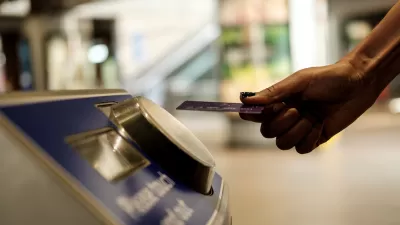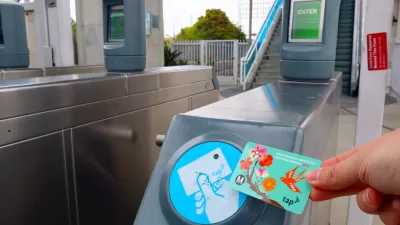There's more than one way to incentive transit ridership with fare capping.

Steven Vance writes to illustrate a simple way, made much easier with current smart phone technology, to incentivize transit ridership: fare capping. Vance defines fare capping as a method for ensuring riders who pay their far using a "trackable" medium like a transit smart card of a mobile app, "will never pay more than the cost of one or more daily and multi-day passes that the transit agency includes in its fare capping policy."
Vance is able to enumerate two scenarios that could benefit from fare capping (i.e., tourists and low-income transit commuters), a number of cities famous for high quality transit services that already have fare capping policies in place (e.g., London and Portland), and a number of cities with aspirations for higher quality transit service and high ridership numbers (e.g., Houston and San Jose).
FULL STORY: Cities that have transit fare capping have fairer fares

Trump Administration Could Effectively End Housing Voucher Program
Federal officials are eyeing major cuts to the Section 8 program that helps millions of low-income households pay rent.

Planetizen Federal Action Tracker
A weekly monitor of how Trump’s orders and actions are impacting planners and planning in America.

Ken Jennings Launches Transit Web Series
The Jeopardy champ wants you to ride public transit.

Washington Legislature Passes Rent Increase Cap
A bill that caps rent increases at 7 percent plus inflation is headed to the governor’s desk.

From Planning to Action: How LA County Is Rethinking Climate Resilience
Chief Sustainability Officer Rita Kampalath outlines the County’s shift from planning to implementation in its climate resilience efforts, emphasizing cross-departmental coordination, updated recovery strategies, and the need for flexible funding.

New Mexico Aging Department Commits to Helping Seniors Age ‘In Place’ and ‘Autonomously’ in New Draft Plan
As New Mexico’s population of seniors continues to grow, the state’s aging department is proposing expanded initiatives to help seniors maintain their autonomy while also supporting family caregivers.
Urban Design for Planners 1: Software Tools
This six-course series explores essential urban design concepts using open source software and equips planners with the tools they need to participate fully in the urban design process.
Planning for Universal Design
Learn the tools for implementing Universal Design in planning regulations.
Heyer Gruel & Associates PA
Ada County Highway District
Institute for Housing and Urban Development Studies (IHS)
City of Grandview
Harvard GSD Executive Education
Toledo-Lucas County Plan Commissions
Salt Lake City
NYU Wagner Graduate School of Public Service





























